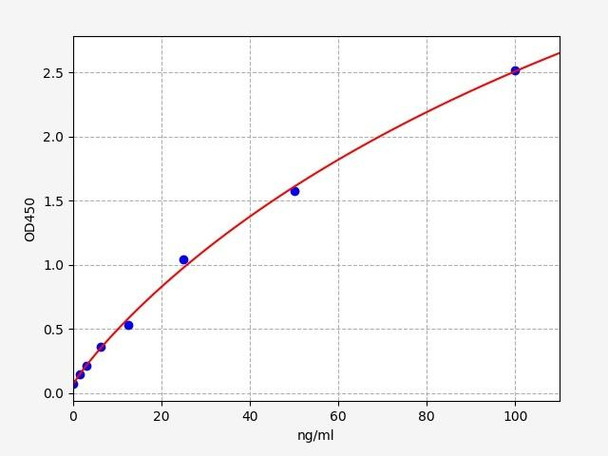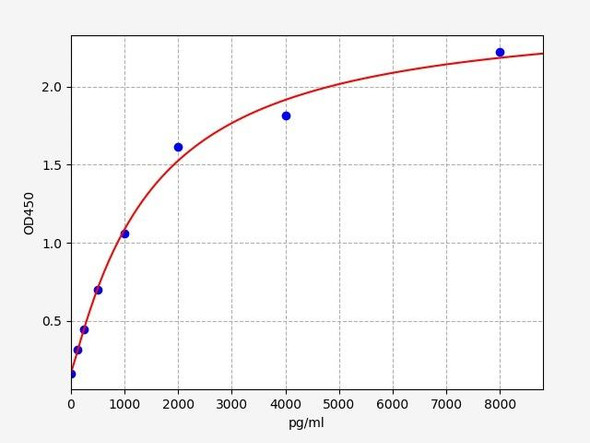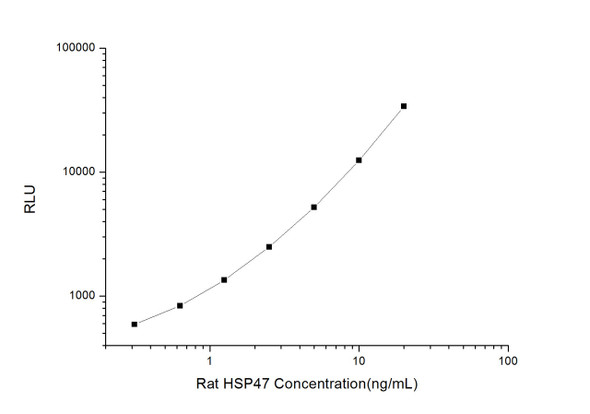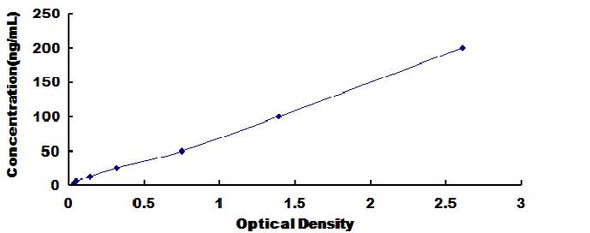Rat Immunology ELISA Kits 2
Rat HSP47 ELISA Kit
- SKU:
- RTFI00873
- Product Type:
- ELISA Kit
- Size:
- 96 Assays
- Uniprot:
- P29457
- Sensitivity:
- 0.938ng/ml
- Range:
- 1.563-100ng/ml
- ELISA Type:
- Sandwich
- Synonyms:
- HSP47
- Reactivity:
- Rat
- Research Area:
- Metabolism
Description
| Product Name: | Rat HSP47 (Heat Shock Protein 47) ELISA Kit |
| Product Code: | RTFI00873 |
| Size: | 96 Assays |
| Target: | Rat HSP47 |
| Alias: | HSP47 |
| Reactivity: | Rat |
| Detection Method: | Sandwich ELISA, Double Antibody |
| Sensitivity: | 0.938ng/ml |
| Range: | 1.563-100ng/ml |
| Storage: | 4°C for 6 months |
| Note: | For Research Use Only |
| Recovery: | Matrices listed below were spiked with certain level of Rat HSP47 and the recovery rates were calculated by comparing the measured value to the expected amount of Rat HSP47 in samples. | ||||||||||||||||
| |||||||||||||||||
| Linearity: | The linearity of the kit was assayed by testing samples spiked with appropriate concentration of Rat HSP47 and their serial dilutions. The results were demonstrated by the percentage of calculated concentration to the expected. | ||||||||||||||||
| |||||||||||||||||
| Intra-Assay: | CV <8% | ||||||||||||||||
| Inter-Assay: | CV <10% |
| Uniprot: | P29457 |
| UniProt Protein Function: | SERPINH1: Binds specifically to collagen. Could be involved as a chaperone in the biosynthetic pathway of collagen. Defects in SERPINH1 are the cause of osteogenesis imperfecta type 10 (OI10). A connective tissue disorder characterized by bone fragility, low bone mass, bowing of limbs due to multiple fractures, short limb dwarfism and blue sclerae. Belongs to the serpin family. |
| UniProt Protein Details: | Chromosomal Location of Human Ortholog: 11q13.5 Cellular Component: extracellular space; endoplasmic reticulum lumen; endoplasmic reticulum; ER-Golgi intermediate compartment Molecular Function:serine-type endopeptidase inhibitor activity; collagen binding; unfolded protein binding Biological Process: extracellular matrix organization and biogenesis; collagen fibril organization; protein maturation; collagen biosynthetic process; response to unfolded protein Disease: Osteogenesis Imperfecta, Type X; Preterm Premature Rupture Of The Membranes |
| NCBI Summary: | This gene encodes a member of the serpin superfamily of serine proteinase inhibitors. The encoded protein is localized to the endoplasmic reticulum and plays a role in collagen biosynthesis as a collagen-specific molecular chaperone. Autoantibodies to the encoded protein have been found in patients with rheumatoid arthritis. Expression of this gene may be a marker for cancer, and nucleotide polymorphisms in this gene may be associated with preterm birth caused by preterm premature rupture of membranes. Alternatively spliced transcript variants have been observed for this gene, and a pseudogene of this gene is located on the short arm of chromosome 9. [provided by RefSeq, May 2011] |
| UniProt Code: | P29457 |
| NCBI GenInfo Identifier: | 333360851 |
| NCBI Gene ID: | 871 |
| NCBI Accession: | NP_001193943.1 |
| UniProt Secondary Accession: | P29457,P29043, Q5XPB4, Q6NSJ6, Q8IY96, Q9NP88, B3KVJ3 |
| UniProt Related Accession: | P50454 |
| Molecular Weight: | |
| NCBI Full Name: | serpin H1 |
| NCBI Synonym Full Names: | serpin peptidase inhibitor, clade H (heat shock protein 47), member 1, (collagen binding protein 1) |
| NCBI Official Symbol: | SERPINH1 |
| NCBI Official Synonym Symbols: | CBP1; CBP2; OI10; gp46; AsTP3; HSP47; PIG14; PPROM; RA-A47; SERPINH2 |
| NCBI Protein Information: | serpin H1; colligin-1; colligin-2; 47 kDa heat shock protein; arsenic-transactivated protein 3; rheumatoid arthritis antigen A-47; cell proliferation-inducing gene 14 protein; rheumatoid arthritis-related antigen RA-A47; serine (or cysteine) proteinase inhibitor, clade H (heat shock protein 47), member 1, (collagen binding protein 1); serine (or cysteine) proteinase inhibitor, clade H (heat shock protein 47), member 2, (collagen-binding protein 2) |
| UniProt Protein Name: | Serpin H1 |
| UniProt Synonym Protein Names: | 47 kDa heat shock protein; Arsenic-transactivated protein 3; AsTP3; Cell proliferation-inducing gene 14 protein; Collagen-binding protein; Colligin; Rheumatoid arthritis-related antigen RA-A47 |
| Protein Family: | Serpin |
| UniProt Gene Name: | SERPINH1 |
| UniProt Entry Name: | SERPH_HUMAN |
| Step | Procedure |
| 1. | Set standard, test sample and control (zero) wells on the pre-coated plate respectively, and then, record their positions. It is recommended to measure each standard and sample in duplicate. Wash plate 2 times before adding standard, sample and control (zero) wells! |
| 2. | Aliquot 0.1ml standard solutions into the standard wells. |
| 3. | Add 0.1 ml of Sample / Standard dilution buffer into the control (zero) well. |
| 4. | Add 0.1 ml of properly diluted sample ( Human serum, plasma, tissue homogenates and other biological fluids.) into test sample wells. |
| 5. | Seal the plate with a cover and incubate at 37°C for 90 min. |
| 6. | Remove the cover and discard the plate content, clap the plate on the absorbent filter papers or other absorbent material. Do NOT let the wells completely dry at any time. Wash plate X2. |
| 7. | Add 0.1 ml of Biotin- detection antibody working solution into the above wells (standard, test sample & zero wells). Add the solution at the bottom of each well without touching the side wall. |
| 8. | Seal the plate with a cover and incubate at 37°C for 60 min. |
| 9. | Remove the cover, and wash plate 3 times with Wash buffer. Let wash buffer rest in wells for 1 min between each wash. |
| 10. | Add 0.1 ml of SABC working solution into each well, cover the plate and incubate at 37°C for 30 min. |
| 11. | Remove the cover and wash plate 5 times with Wash buffer, and each time let the wash buffer stay in the wells for 1-2 min. |
| 12. | Add 90 µL of TMB substrate into each well, cover the plate and incubate at 37°C in dark within 10-20 min. (Note: This incubation time is for reference use only, the optimal time should be determined by end user.) And the shades of blue can be seen in the first 3-4 wells (with most concentrated standard solutions), the other wells show no obvious color. |
| 13. | Add 50 µL of Stop solution into each well and mix thoroughly. The color changes into yellow immediately. |
| 14. | Read the O.D. absorbance at 450 nm in a microplate reader immediately after adding the stop solution. |
When carrying out an ELISA assay it is important to prepare your samples in order to achieve the best possible results. Below we have a list of procedures for the preparation of samples for different sample types.
| Sample Type | Protocol |
| Serum: | If using serum separator tubes, allow samples to clot for 30 minutes at room temperature. Centrifuge for 10 minutes at 1,000x g. Collect the serum fraction and assay promptly or aliquot and store the samples at -80°C. Avoid multiple freeze-thaw cycles. If serum separator tubes are not being used, allow samples to clotovernight at 2-8°C. Centrifuge for 10 minutes at 1,000x g. Removeserum and assay promptly or aliquot and store the samples at-80°C. Avoid multiple freeze-thaw cycles. |
| Plasma: | Collect plasma using EDTA or heparin as an anti-coagulant. Centrifuge samples at 4°C for 15 mins at 1000 × g within 30 mins of collection. Collect the plasma fraction and assay promptly or aliquot and store the samples at -80°C. Avoid multiple freeze-thaw cycles.Note: Over haemolysed samples are not suitable for use with this kit. |
| Urine & Cerebrospinal Fluid: | Collect the urine (mid-stream) in a sterile container, centrifuge for 20 mins at 2000-3000 rpm. Remove supernatant and assay immediately. If any precipitation is detected, repeat the centrifugation step. A similar protocol can be used for cerebrospinal fluid. |
| Cell Culture Supernatant: | Collect the cell culture media by pipette, followed by centrifugation at 4°C for 20 mins at 1500 rpm. Collect the clear supernatant and assay immediately. |
| Cell Lysates: | Solubilize cells in lysis buffer and allow to sit on ice for 30 minutes. Centrifuge tubes at 14,000 x g for 5 minutes to remove insoluble material. Aliquot the supernatant into a new tube and discard the remaining whole cell extract. Quantify total protein concentration using a total protein assay. Assay immediately or aliquot and store at ≤ -20°C. |
| Tissue Homogenates: | The preparation of tissue homogenates will vary depending upon tissue type. Rinse tissue with 1X PBS to remove excess blood & homogenizein 20ml of 1X PBS (including protease inhibitors) and store overnight at ≤ -20°C. Two freeze-thaw cycles are required to break the cell membranes. To further disrupt the cell membranes you can sonicate the samples. Centrifuge homogenates for 5 mins at 5000xg. Remove the supernatant and assay immediately or aliquot and store at -20°C or-80°C. |
| Tissue Lysates: | Rinse tissue with PBS, cut into 1-2 mm pieces, and homogenize with a tissue homogenizer in PBS. Add an equal volume of RIPA buffer containing protease inhibitors and lyse tissues at room temperature for 30 minutes with gentle agitation. Centrifuge to remove debris. Quantify total protein concentration using a total protein assay. Assay immediately or aliquot and store at ≤ -20 °C. |
| Breast Milk: | Collect milk samples and centrifuge at 10,000 x g for 60 min at 4°C. Aliquot the supernatant and assay. For long term use, store samples at -80°C. Minimize freeze/thaw cycles. |






